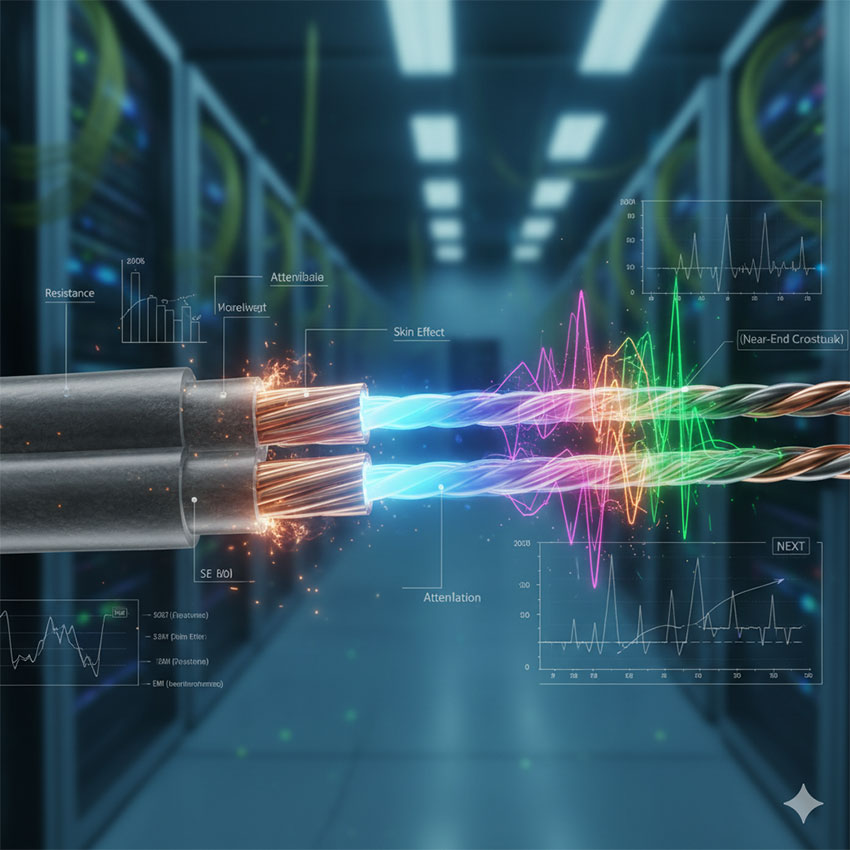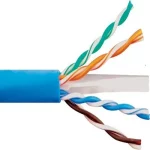In an era defined by hyperscale data centers, 5G/6G backhaul, and multi-gigabit enterprise networks, the integrity of the physical layer is paramount. While network engineers often focus on protocols and routing algorithms, the fundamental limitations of data transmission are governed by the immutable laws of physics. This white paper provides a rigorous examination of the two primary antagonists in copper-based channel performance: Attenuation (signal loss) and Crosstalk (signal interference). We will move beyond simplistic definitions to explore the underlying electromagnetic principles, their mathematical models, and the standardized measurement methodologies. Finally, we will detail the engineering solutions and mitigation techniques—from advanced cable design to sophisticated digital signal processing (DSP)—that enable modern high-speed standards like 10GBASE-T, 40GBASE-T, and beyond to function reliably. The goal is to equip network designers, cabling installers, and IT professionals with a deeper understanding of the physical medium, enabling better design choices, more effective troubleshooting, and future-proofed infrastructure investments.
1. Introduction: The Battle on the Channel
Every data transmission is a battle against entropy. As an electrical signal propagates along a copper conductor or a light pulse travels through a glass fiber, it is subjected to various degrading forces. The channel—the physical path between transmitter and receiver—is not a perfect, lossless medium. Its imperfections introduce distortions that, if left unmanaged, render the received signal unintelligible.
The Signal-to-Noise Ratio (SNR) is the single most critical metric in determining the performance and capacity of a communication channel, as defined by the seminal Shannon-Hartley Theorem:
C = B × log₂(1 + SNR)
Where:
- C is the channel capacity in bits per second.
- B is the bandwidth of the channel in Hertz.
- SNR is the Signal-to-Noise Ratio (a dimensionless ratio).
This theorem establishes a hard limit. To increase data rate (C), we must either increase bandwidth (B) or improve the SNR. In networking, we increase the bandwidth by using higher-frequency signals. However, this exacerbates the two primary challenges we will discuss:
- Attenuation: The desired signal (S) becomes weaker as frequency and distance increase.
- Crosstalk: The noise (N) component increases, as higher-frequency signals are more prone to radiating and interfering with adjacent conductors.
Thus, the entire endeavor of high-speed networking is an effort to engineer the physical layer to maximize SNR. This paper dissects the physics of what diminishes ‘S’ and increases ‘N’.
2. The Physics of Attenuation (Insertion Loss)
Attenuation, often called Insertion Loss in cabling standards, is the gradual loss of signal strength as it travels through a medium. It is measured in Decibels (dB), a logarithmic unit that expresses the ratio between two power levels.
2.1 The Decibel (dB): A Unit of Relative Power
Understanding dB is crucial. Given a power ratio P_out / P_in, the loss in decibels is calculated as:
Attenuation (dB) = 10 × log₁₀ (P_out / P_in)
A negative dB value indicates a loss (P_out < P_in), which is the norm for attenuation. For example, a -3 dB loss means the output power is half the input power. A -10 dB loss means the output power is one-tenth of the input. This logarithmic scale is useful because it converts multiplicative relationships into additive ones, making it easier to calculate total loss across multiple components (e.g., cable, connectors, patches).
2.2 Primary Causes of Attenuation in Copper Cables
In copper cables (specifically Unshielded Twisted Pair – UTP), attenuation is primarily caused by three physical phenomena:
A. Conductor Resistance (I²R Losses)
The fundamental resistance of the copper conductor converts electrical energy into heat. This is an Ohmic loss. The catch is that resistance is not constant with frequency due to the Skin Effect. As frequency increases, electrical current is forced to flow predominantly on the outer “skin” of the conductor. The effective cross-sectional area for current flow decreases, thus increasing the AC resistance. The skin depth (δ) is given by:
δ = √(ρ / (π × f × μ))
Where:
- ρ is the resistivity of the conductor.
- f is the frequency.
- μ is the permeability of the conductor.
This relationship shows that skin depth decreases with the square root of frequency. At high frequencies (e.g., 500 MHz for Cat 6A), the skin effect is so pronounced that using larger-diameter conductors beyond a certain point yields diminishing returns for attenuation improvement.
B. Dielectric Absorption
The insulating material (typically PVC, PE, or FEP) between the conductors is not a perfect insulator. The alternating electric field of the signal causes the molecules in the dielectric to polarize and align themselves with the field. This molecular movement absorbs energy from the signal and converts it to heat. The loss tangent (tan δ) of the material quantifies this effect. Higher-quality cables use low-loss dielectrics like FEP (Teflon) to minimize this absorption.
C. Impedance Mismatch and Return Loss
A cable has a characteristic impedance (e.g., 100Ω for Ethernet UTP). If this impedance is not matched perfectly at connection points (connectors, punch-downs, or the receiver/transmitter circuitry), a portion of the signal is reflected back toward the source. These reflections represent a loss of power in the forward direction and can also cause signal distortion. Return Loss is a measurement that quantifies these reflections. Poor termination practices are a major contributor to impedance mismatch and, consequently, increased effective attenuation.
2.3 Attenuation in Fiber Optic Cables
In fiber optics, attenuation mechanisms are different but equally governed by physics:
- Scattering: Rayleigh scattering, caused by microscopic variations in the density of the glass, is the fundamental loss limit. It is inversely proportional to the fourth power of the wavelength (λ⁻⁴), which is why longer wavelengths (1310nm, 1550nm) have lower attenuation than shorter ones (850nm).
- Absorption: Impurities in the glass, such as water ions (OH⁻), absorb light energy. Modern low-water-peak fibers have virtually eliminated this issue.
- Macro/Microbending: Physical bends in the fiber cause light to escape the core.
Fiber attenuation is significantly lower than copper, allowing for much longer transmission distances.
2.4 The Frequency-Dependence of Attenuation
A critical takeaway is that attenuation is not flat across all frequencies. It increases proportionally with the square root of frequency (√f) for copper cables due to the combined effects of skin effect and dielectric losses. This is why cabling standards specify Insertion Loss plots that slope downwards as frequency increases. A channel that passes at 100 MHz may fail miserably at 500 MHz due to this frequency-dependent loss.
3. The Physics of Crosstalk: The Enemy Within
Crosstalk is the unwanted coupling of signal from one pair of conductors to another within the same cable. It is the dominant noise source (N) in balanced twisted-pair cabling. There are several types of crosstalk, each with unique characteristics.
3.1 The Electromagnetic Coupling Mechanism
Crosstalk occurs due to two fundamental physical principles:
- Inductive Coupling: A changing current in the “disturbing” pair (the aggressor) creates a changing magnetic field around it. This changing magnetic field induces a voltage in the “disturbed” pair (the victim), as described by Faraday’s Law of Induction.
- Capacitive Coupling: The two pairs of wires act like the plates of a capacitor. The changing voltage on the aggressor pair induces a current in the victim pair via this parasitic capacitance.
In a balanced twisted pair, the coupling to each wire in the victim pair is almost identical. The receiver is designed to detect the difference between these two wires (the differential mode). If the coupling were perfectly equal, the induced noise would be a common-mode signal that the receiver would reject. However, imperfections in cable geometry (untwisting, uneven dielectric) mean the coupling is never perfectly balanced, resulting in a differential noise signal—this is crosstalk.
3.2 Types of Crosstalk
A. Near-End Crosstalk (NEXT)
NEXT is measured at the same end of the cable as the transmitter. The strong signal being sent from the local transmitter couples into the weak signal being received from the far end. Because the aggressor signal is very strong at the near-end, NEXT is a particularly severe problem. It is measured as a power ratio between the disturbing signal and the coupled signal. A higher (less negative) dB value indicates better performance (less crosstalk). Power Sum NEXT (PSNEXT) is a critical parameter that sums the crosstalk from all three adjacent pairs, providing a realistic assessment of the noise environment in a four-pair system like Ethernet.
B. Far-End Crosstalk (FEXT)
FEXT is measured at the opposite end of the cable from the transmitter. The aggressor signal couples into the victim signal after both have traveled the length of the cable. Since both signals have been attenuated, FEXT is generally less severe than NEXT. However, for full-duplex transmission (sending and receiving on all pairs simultaneously), it is still significant.
C. Alien Crosstalk (ANEXT)
This is the most disruptive form of crosstalk in high-frequency applications (Cat 6A and above). ANEXT is the coupling of a signal from a pair in an adjacent cable, not just within the same cable. It is exceptionally difficult to mitigate because it is not affected by the internal design of a single cable. The signal acts like an external radio frequency interference (RFI) source. ANEXT is the primary reason that Cat 6A cabling requires specialized designs like separated pairs, larger jackets, or overall shields.
4. Measurement and Standards: Quantifying the Channel
International standards from bodies like ANSI/TIA and ISO/IEC define the precise limits for attenuation and crosstalk to ensure interoperability.
- ANSI/TIA-568.2-D: Defines requirements for balanced twisted-pair cabling in North America.
- ISO/IEC 11801-1: The international equivalent.
These standards specify parameters like:
- Insertion Loss (IL): The maximum allowed signal loss for a given channel length and frequency.
- Next Loss: The minimum required isolation between pairs at the near-end.
- Attenuation-to-Crosstalk Ratio (ACR): A derived value (NEXT – IL) that is a direct analog of SNR. A positive ACR is essential for a functional link. The related Equal Level FEXT (ELFEXT) is FEXT normalized to the attenuation of the victim pair.
- Power Sum ACR (PSACR): The SNR equivalent considering crosstalk from all pairs.
Certification testing with a cable analyzer (like a Fluke Networks DSX-8000) is the only way to verify that an installed link meets these stringent standards.
5. Mitigation Techniques: Engineering the Solution
The history of structured cabling is a history of the fight against attenuation and crosstalk. Mitigation happens at multiple levels.
5.1 Cable Design Innovations
- Twisting: The primary defense against crosstalk. Twisting the two wires in a pair ensures that the coupling from an aggressor pair alternates in polarity along the length of the cable, causing the induced noise to cancel itself out. Different pair lays (twists per meter) within the same cable prevent the coupling from becoming periodic and constructive.
- Improved Dielectrics: Using low-loss materials like FEP reduces dielectric absorption, directly improving attenuation performance.
- Precision Engineering: Maintaining consistent pair geometry and impedance is critical for minimizing return loss and balancing crosstalk cancellation.
- Alien Crosstalk Shields: For Cat 6A and higher, cables may use individual pair shields (U/FTP) or an overall screen (F/UTP, S/FTP) to physically block electromagnetic radiation, preventing ANEXT.
5.2 Active Mitigation: Digital Signal Processing (DSP)
While cable design addresses the physical problem, modern Ethernet PHY chips (e.g., for 10GBASE-T) use sophisticated DSP to combat what the cable cannot eliminate.
- Cancellation Algorithms: The transceiver knows the signal it is sending. It can therefore create a mathematical model of the expected crosstalk it will generate in the receive path and subtract this “echo” from the received signal. This is essential for mitigating NEXT in full-duplex systems.
- Adaptive Equalization: To combat attenuation and frequency-dependent loss, the receiver uses equalizers. These are filters that amplify high frequencies more than low frequencies, effectively flattening the channel’s frequency response.
- Forward Error Correction (FEC): FEC adds redundant data to the transmission, allowing the receiver to detect and correct a limited number of errors caused by noise bursts that the other techniques couldn’t eliminate.
Conclusion
The pursuit of higher network speeds is fundamentally a battle against the laws of physics, fought on the ground of the physical layer. Attenuation and crosstalk are not mere installation annoyances; they are deeply rooted electromagnetic phenomena that define the performance limits of copper-based channels. A profound understanding of their causes—from the skin effect and dielectric losses to electromagnetic coupling—is essential for anyone designing, installing, or maintaining a modern network infrastructure.
The solutions are a testament to engineering ingenuity, combining precision mechanical design in cabling with increasingly powerful digital signal processing in active equipment. As we look toward standards beyond 40GBASE-T, the challenges will only intensify, requiring ever-more sophisticated materials science, manufacturing tolerances, and signal processing algorithms to maintain the integrity of the signal and uphold the promise of a connected world. The physical layer, therefore, remains the critical foundation upon which the entire digital ecosystem is built.





